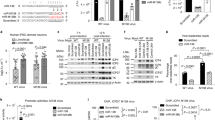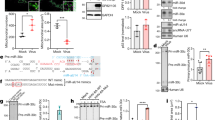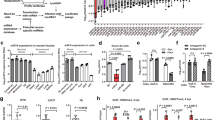Abstract
MicroRNAs (miRNAs) are a class of small RNA molecules that regulate the stability or the translational efficiency of target messenger RNAs (mRNAs)1,2. The latency-associated transcript (LAT) of herpes simplex virus-1 (HSV-1) is the only viral gene expressed during latent infection in neurons3. LAT inhibits apoptosis and maintains latency by promoting the survival of infected neurons4. No protein product has been attributed to the LAT gene and the mechanism by which LAT protects cells from apoptosis is not yet known. Here we show that a miRNA encoded by the HSV-1 LAT gene confers resistance to apoptosis. Neuroblastoma cells transfected with a fragment of the LAT gene show reduced susceptibility to cell death. The anti-apoptotic function of LAT has been mapped to a region within the first exon5,6. We have identified and characterized a microRNA (miR-LAT) generated from the exon 1 region of the HSV-1 LAT gene. The LAT miRNA was found to accumulate in cells transiently transfected with the LAT gene fragment or infected with a wild-type strain of HSV-1. A mutant virus in which a 372-nucleotide fragment encompassing the mature miRNA was deleted neither protected the infected cells from apoptosis nor generated an miRNA. miR-LAT exerts its anti-apoptotic effect by downregulation of transforming growth factor (TGF)-β 1 and SMAD3 expression, both of which are functionally linked in the TGF-β pathway. Our results suggest that the miRNA encoded by the HSV-1 LAT gene regulates the induction of apoptosis in infected cells by modulation of TGF-β signalling and thus contributes to the persistence of HSV in a latent form in sensory neurons.
This is a preview of subscription content, access via your institution
Access options
Subscribe to this journal
Receive 51 print issues and online access
$199.00 per year
only $3.90 per issue
Buy this article
- Purchase on Springer Link
- Instant access to full article PDF
Prices may be subject to local taxes which are calculated during checkout




Similar content being viewed by others
References
Ambros, V. MicroRNAs: tiny regulators with great potential. Cell 107, 823–826 (2001)
Bartel, D. P. MicroRNAs: genomics, biogenesis, mechanism and function. Cell 116, 281–297 (2004)
Jones, C. Herpes simplex virus type 1 and bovine herpesvirus 1 latency. Clin. Microbiol. Rev. 16, 79–95 (2003)
Perng, G. C. et al. Virus-induced neuronal apoptosis blocked by the herpes simplex virus latency-associated transcript. Science 287, 1500–1503 (2000)
Ahmed, M., Lock, M., Miller, C. G. & Fraser, N. W. Regions of the herpes simplex virus type 1 latency-associated transcript that protect cells from apoptosis in vitro and protect neuronal cells in vivo. J. Virol. 76, 717–729 (2002)
Inman, M. et al. Region of herpes simplex virus type 1 latency-associated transcript sufficient for wild-type spontaneous reactivation promotes cell survival in tissue culture. J. Virol. 75, 3636–3646 (2001)
Bennasser, Y., Le, S. Y., Benkirane, M. & Jeang, K. T. Evidence that HIV-1 encodes an siRNA and a suppressor of RNA silencing. Immunity 22, 607–619 (2005)
Laferriere, A., Gautheret, D. & Cedergren, R. An RNA pattern matching program with enhanced performance and portability. Comput. Appl. Biosci. 10, 211–212 (1994)
Zuker, M. Mfold web server for nucleic acid folding and hybridization prediction. Nucleic Acids Res. 31, 3406–3415 (2003)
Tomari, Y. & Zamore, P. D. Perspective: machines for RNAi. Genes Dev. 19, 517–529 (2005)
John, B. et al. Human MicroRNA targets. PLoS Biol. 2, e363 (2004)
Derynck, R., Akhurst, R. J. & Balmain, A. TGF-β signaling in tumor suppression and cancer progression. Nature Genet. 29, 117–129 (2001)
Feng, X. H. & Derynck, R. Specificity and versatility in TGF-β signaling through Smads. Annu. Rev. Cell Dev. Biol. 21, 659–693 (2005)
Schuster, N. & Krieglstein, K. Mechanisms of TGF-β-mediated apoptosis. Cell Tissue Res. 307, 1–14 (2002)
Zawel, L. et al. Human Smad3 and Smad4 are sequence-specific transcription activators. Mol. Cell 1, 611–617 (1998)
Jin, L. et al. Identification of herpes simplex virus type 1 latency-associated transcript sequences that both inhibit apoptosis and enhance the spontaneous reactivation phenotype. J. Virol. 77, 6556–6561 (2003)
Jin, L. et al. A herpes simplex virus type 1 mutant expressing a baculovirus inhibitor of apoptosis gene in place of latency-associated transcript has a wild-type reactivation phenotype in the mouse. J. Virol. 79, 12286–12295 (2005)
Sullivan, C. S. & Ganem, D. MicroRNAs and viral infection. Mol. Cell 20, 3–7 (2005)
Schutz, S. & Sarnow, P. Interaction of viruses with the mammalian RNA interference pathway. Virology 344, 151–157 (2006)
Chendrimada, T. P. et al. TRBP recruits the Dicer complex to Ago2 for microRNA processing and gene silencing. Nature 436, 740–744 (2005)
Lau, N. C., Lim, L. P., Weinstein, E. G. & Bartel, D. P. An abundant class of tiny RNAs with probable regulatory roles in Caenorhabditis elegans. Science 294, 797–799 (2001)
Pfeffer, S., Lagos-Quintana, M. & Tuschl, T. in Current Protocols in Molecular Biology (eds Ausbel, F. M. et al.) 26.4.1–26.4.18 (Wiley Interscience, New York, 2003)
Acknowledgements
We thank K.-T. Jeang for the GFP-shRNA construct; Z. Mourelatos for the PRL-TK vector; and R. Sheikhattar for the Dicer polyclonal antibody. We thank B. Brunk for help with the computational analysis. We also thank T. Chendrimada for advice and help with miRNA protocols. We acknowledge S. Berges for critical review of the manuscript. This work was supported by a National Institute of Health grant. A.G.H. is supported by an NSF Career Award Grant. Author Contributions A.G. conceived the project and carried out all experiments described. J.J.G. provided technical assistance. P.S. and A.G.H. developed and applied computational algorithm for miRNA detection and target prediction. N.W.F. directed and supervised the experimental work and interpretation of data. The manuscript was prepared by A.G. and N.W.F.
Author information
Authors and Affiliations
Corresponding author
Ethics declarations
Competing interests
Reprints and permissions information is available at npg.nature.com/reprintsandpermissions. The authors declare no competing financial interests.
Supplementary information
Supplementary Figures
This file contains Supplementary Figures 1–7. This file contains errors in Supplementary Figures 3–5. Please refer to below Corrigendum. (PDF 3101 kb)
Supplementary Methods
This file contains additional detailed description of protocols used in this study. (PDF 78 kb)
Supplementary Figure 3
This file contains the correct Supplementary Figure 3. Please refer to the below Corrigendum for details. (PDF 1070 kb)
Supplementary Figure 4
This file contains the correct Supplementary Figure 4. Please refer to the below Corrigendum for details. (PDF 1048 kb)
Supplementary Figure 5
This file contains the correct Supplementary Figure 5. Please refer to the below Corrigendum for details. (PDF 982 kb)
Corrigendum
This file contains details of an error in the original publication of this Supplementary Information. (DOC 23 kb)
Rights and permissions
About this article
Cite this article
Gupta, A., Gartner, J., Sethupathy, P. et al. Anti-apoptotic function of a microRNA encoded by the HSV-1 latency-associated transcript. Nature 442, 82–85 (2006). https://doi.org/10.1038/nature04836
Received:
Accepted:
Published:
Issue Date:
DOI: https://doi.org/10.1038/nature04836
This article is cited by
-
An unnatural enzyme with endonuclease activity towards small non-coding RNAs
Nature Communications (2023)
-
Label-free detection of microRNA: two-stage signal enhancement with hairpin assisted cascade isothermal amplification and light-up DNA-silver nanoclusters
Microchimica Acta (2020)
-
HSV-2-encoded miRNA-H4 Regulates Cell Cycle Progression and Act-D-induced Apoptosis in HeLa Cells by Targeting CDKL2 and CDKN2A
Virologica Sinica (2019)
-
HSV-1-encoded microRNA miR-H1 targets Ubr1 to promote accumulation of neurodegeneration-associated protein
Virus Genes (2018)
-
The Expression of Human Cytomegalovirus MicroRNA MiR-UL148D during Latent Infection in Primary Myeloid Cells Inhibits Activin A-triggered Secretion of IL-6
Scientific Reports (2016)
Comments
By submitting a comment you agree to abide by our Terms and Community Guidelines. If you find something abusive or that does not comply with our terms or guidelines please flag it as inappropriate.



